Paths II
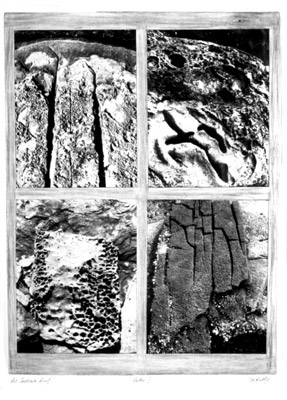
Paths II
photopolymer intaglio
75 x 56 cm.

Paths II
photopolymer intaglio
75 x 56 cm.
April 25, 2004 in Paths, Printworks Comments Off on Paths II
Coincidences posted an interesting article about “Big Prints, the Art-Making Impulse, and Time-Motion Panoramas” that has prompted me to add some comments on his blog and here.
The extra large digitally printed photographs that we now see in galleries have become possible with the growth of very large, high quality archival inkjet printers at a more reasonable price (though still not cheap) compared to the original giclee printers of a few years ago. It has really opened up immense possibilities for artists as well as photographers.
As mostly a photo-based printmaker, I find I am more interested in the photographers that have a unique way of “making” their images, whether it’s with an unusual camera technique or with PhotoShop or something else. While I don’t question the artistic vision of many realistic photographers, my own personal aesthetic, perhaps now a little old-fashioned, is to see the hand of the artist at work in some way, using the camera as a tool amongst many others.
Hmm, this has led me back to some recent discussions about “true” vs. manipulated photography.
Thanks to Coincidences for mentioning my blog regarding conversations about the art-making impulse.
ADDENDUM April 25.04:
Talking about Big Prints, Caryn Coleman wrote a great commentary in The Art Weblog about whether big prints are better….recommended reading!
April 18, 2004 in Being an Artist, Digital printmaking, Photography, Tools and technology Comments Off on photography and art
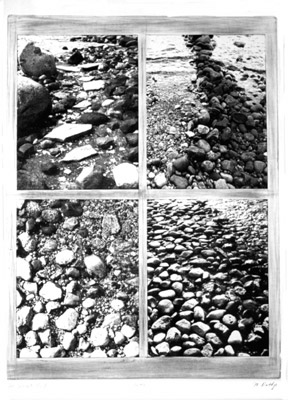
Paths III
Photopolymer intaglio
76 x 56 cm.
April 17, 2004 in Paths, Printworks 3 Comments »
As mentioned in a couple of my recent posts, there has been a lot of discussion on why we make art, and this has led me to think more about creativity. Cassandra wrote a few days ago (scroll down to April 14th entry) about her thoughts on writing letters, books and blogs, and about creativity. I like these wise words:
“There’s also another side to how we view creativity, and the way we put certain types of achievement up on a pedestal. If we insist on seeing creative work as heading toward specific public goals, and Art as being defined by these big monolithic accomplishments – the book, symphony, masterpiece painting – we will not only set ourselves up to fall short, but we run the risk of being blind to the art that exists in everyday creation, in the thoughts and creative acts that arise when we lift our eyes from a book, or making a meal, or stop to hear a bird song. All those things need to go into our “big art”, if that’s where we’re headed, but they are also important ends in themselves, as blogging and letter-writing remind us. I think we need to remember that, not only to validate what we are doing but because so many people are also doing this process — of perceiving and thinking and expressing or remembering — everyday, without ever writing anything down. It’s important to remember that their thoughts and perceptions also layer throughout life to create masterpieces: wise, perceptive, interesting people, without whom the world would be so impoverished.”
April 16, 2004 in Being an Artist, Other artists Comments Off on on creativity
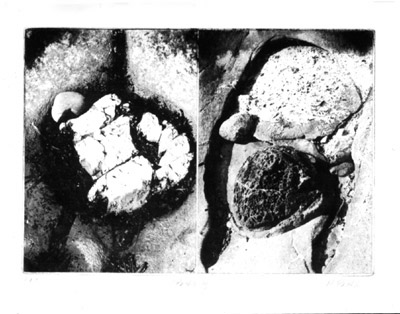
Paths IV
Photopolymer intaglio
40.5 x 51 cm.
April 15, 2004 in Paths, Printworks Comments Off on Paths IV
A few days ago I posted a discussion about why artists are compelled to make art. It’s certainly a popular subject. Artist Danny Gregory posted in his blog today “The fundamental question: Why do you do it?”, asking his artist readers to reply. When I last looked there were 31 replies, all very well worth reading.
UPDATE: (April 16/04) So many comments on this subject, and I also want to add more, slightly off the topic but still relevant, I hope:
I believe every human is born creative, look at children! Somewhere along the way, some lose that natural drive; sometimes it’s killed by uninformed teachers who insist on colouring-inside-the-lines-of-photocopied-colouring-book-pictures etc. Partly, the education system is at fault in the teaching of the teachers, but it really is a lack in our society that would need a revolution to change. Of course, not everyone needs to be a professional artist, but creativity is, I firmly believe, an important part of every wholesome well-rounded person. An appreciation for and support of the arts also helps those artists who are trying to make a living.
April 14, 2004 in Being an Artist Comments Off on more on Why Make Art
I have just found an artist’s blog that has really piqued my interest. Ivan Pope in the UK does multimedia installation work that is very different from my printmaking, but his clear descriptions of his life as an artist who blogs, mirror much of my own. I like this Dear Diary:
“It occurs to me that this blog is like a Diary […] purely a look at the stuff that I do, the work that I make and the things that surround me.[…] I’ve spent the last week recoiling from making work. I think I burn myself out in phases, then some consolidation. Plus, there is always a lot of other stuff around to get on with, paperwork, kids, work, school.[…] My mind goes on making work, but my body sort of abdicates. It tries to get back to it, but there are too many things in the way. And some big fears.”
And Doing the art thing :
“This blog is supposed to get me thinking about, considering, the minutae of my life as an artist.[…] I intend to have a career in art myself,[…], I know the value of the market, the PR expert, the phone-pickerupper, the booster. Up to a point artists have to be all of these things to themselves, and its a very hard trick to play. Almost the best that you can hope is that you have such a belief in your work that boosting it, telling the world about it is easy and first nature. If this is true and it works, then someone will come along to pick up the job. Oh, and to do the paperwork. Please.”
April 13, 2004 in Being an Artist, Other artists Comments Off on Life as an Artist
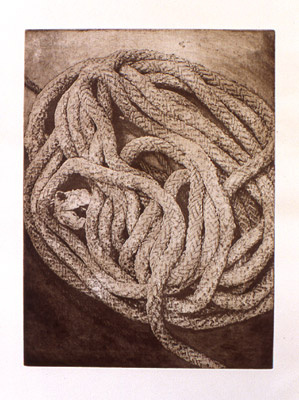
Paths XI
Photopolymer intaglio
76 x 57 cm.
April 12, 2004 in Paths, Printworks Comments Off on Paths XI
The latest newsletter CALENDAR from CARFAC arrived in my mailbox last week. Its arrival reminded me how important this organization is to Canadian artists.
The first article, “A Living Income for Artists: a proposal for a significant increase in artists’ fees” is well worth reading. “It was just over 35 years ago that the first artists’ fees were paid for the public exhibition and use of an artwork. While fees are a welcome addition, they are still not considered to be a significant source of an artist’s income. Many artists still use their fee to help offset the costs of the exhibition for which they are being paid. It would seem that it’s time that fees began to be considered a significant source of income and formed the basis of a ‘Living Income for Artists’.”
Read all about this and more in the Calendar: Download pdf file
There’s lots more interesting reading: reports about CARCC’s (the copyright collective) move to Ottawa, and from the provincial affiliates, other artists’ organizations, plus lots of membership information.
And, in the “From our ARTchives” column (page 14) is an article written by Jane Martin, “Why Does It Make a Difference? Reactions, Myths and Reality”, referring back to one published in Feb.1981 that discusses how women artists were funded substantially less than their male peers. “…in this country the visual arts field is dominated by men”.
In this follow-up report 23 years later: “2004 Update: Has it Made a Difference?”, some improvement was noted. For example, the Art Bank jury “bought more works by women than by men. But when we did the math, we saw that most of the money was going to male artists who were a whole lot less timid when it came to pricing their work. […] it’s important to note that what I was arguing for in the “Why Does It Make A Difference?” section was not the substitution of a female boss bunch for the reigning male one, but for a lot of different ways of looking at art, of doing art, for the little streams of excellent and exciting work. I was challenging the incestuousness of the jury and recipient pool, the idea that there was a Mainstream, and that it was Excellent. While back then, most of the Big Fish in the pool were male; most male artists weren’t in the pool with the big fish either.”
April 12, 2004 in Being an Artist Comments Off on CARFAC supports artists
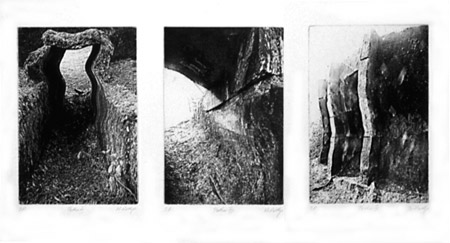
Paths at Dollar Mill
Triptych: Paths VII, Paths VIII, Paths IX (left to right)
Photopolymer intaglio
35.5 x 28 cm each
April 10, 2004 in Paths, Printworks | Tags: Photopolymer intaglio
Comments Off on Paths at Dollar Mill
© Marja-Leena Rathje 2004-2026